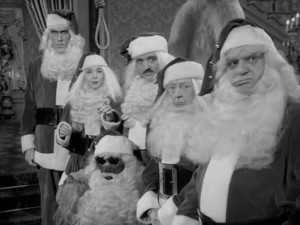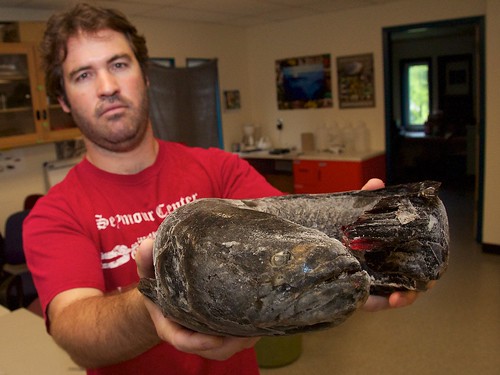The Bechdel Test is (was) a hot conversation topic at the Mid-Atlantic Popular & American Culture Association (MAPACA) conference (last month, which is when I wrote this post I’m only now getting around to editing & posting).
In 1985, a strip from Alison Bechdel’s Dykes to Watch Out For comic titled “The Rule” featured two women talking about going to the movies. One explains her criteria for choosing a movie: it has to have at least 2 female characters, those characters have to talk to one another, and that dialogue has to be about something other than a man.
Recently, four Swedish Theaters announced they’ll be applying the Bechdel Test to the movies they show and giving movies that pass an “A” rating.
Yesterday – on her blog and in interviews with other media outlets – Bechdel expressed discomfort with the dogmatic way her work is being used.
For a very long time, The Rule wasn’t a widespread cultural phenomenon – it was a thing women and gender studies scholars talked about in bars. Over the last decade, the Bechdel Test, as it’s now known, has became something akin to one of those weird conventional wisdom-y popular science phenomenon.
Now everyone thinks it’s a great tool for studying gender film, except most of the people who study gender and film.
To many (most) of the feminist lit and culture scholars I know, the Bechdel Test has gone from a thought-provoking conversation starter to a reductionist tool.
I like the idea of the Bechdel Test. It could be a great tool for opening up conversations about women in film and on television as subjects and not objects, but as a blunt instrument it’s a lousy lens through which to actually analyze the representation of power, discrimination, oppression, or ideology on-screen. Or to discuss gender in ways that aren’t hetero-normative and divided into a strict male-female dichotomy, for that matter.
The test doesn’t take into account semiotics, character development, context, or the very fact that film is a visual medium. That’s hard to quantify.
Stefan Solomon’s post, “What the Bechdel test doesn’t tell us about women on film,” includes several film clips that speak louder than words about these problems.
A few months ago I watched a brutal argument on facebook wherein a group of Bechdel Test devotees shamed a female friend who was defending her fandom of Firefly. I hadn’t realized until then how poorly the show does on the test.
Now, in all this talk of feminist movies and tv shows that fail or misogynistic ones that pass, I don’t mean to suggest that there aren’t plenty of movies that fail for well-deserved reasons.
A few days ago, a Guardian article included some relevant statistics on the movie business in 2013:
Of the top 100 US films in 2011, women accounted for 33% of all characters and only 11% of the protagonists, according to a study by the San Diego-based Centre for the Study of Women in Television and Film.
Another study, by the Annenberg Public Policy Centre at the University of Pennsylvania, showed that the ratio of male to female characters in movies has remained at about two to one for at least six decades. That study, which examined 855 top box-office films from 1950-2006, showed female characters were twice as likely to be seen in explicit sexual scenes as males, while male characters were more likely to be seen as violent.
“Apparently Hollywood thinks that films with male characters will do better at the box office. It is also the case that most of the aspects of movie-making – writing, production, direction, and so on – are dominated by men, and so it is not a surprise that the stories we see are those that tend to revolve around men,” Amy Bleakley, the study’s lead author, said in an email.
I can understand why people who don’t want to spend their time thinking about critical analysis like the Bechdel Test – it’s a checklist.
If. Then. So.
This debate about whether Black Swan passes the test illustrates the multiplicity of ways one can interpret the test itself. As I learned at breakfast this morning, when it was in theaters this was one of those movies people seemed to enjoy railing at film scholars about it to “prove” the worth of the test.
(I don’t have enough conference-coffee coursing through my system yet to recall some of the other fascinating examples that were discussed this morning. Sorry).
As an example of why gaze and context and on-screen action (and wardrobe!) matters, Solomon discusses Alien, the film that has become the gold standard:
Bechdel’s original comic strip ends on an interesting note. For the cartoon character speaking, the last movie that passed the test (circa 1985) was Ridley Scott’s Alien. In that film, Ripley (Sigourney Weaver) and the other female crew-member, Lambert (Veronica Cartwright), discuss the film’s monster (thereby passing the Bechdel test).
But for those of us who know the film, we will also know that it is not dialogue, but the lack of dialogue that makes Alien such a haunting experience. Indeed, who really remembers the words that pass between Ripley and Lambert on board the Nostromo?
Feminist film critics have been far more interested in how we interpret the final scene, in which Ripley – the lead character and sole survivor – is reduced to her underwear.
In these last shots, the camera, which until now has moved in such a fascinating way through the corridors of the ship, seems to revert to old Hollywood habits, embarrassingly ogling Weaver’s body (or does it?)
The TV Tropes entry on the Bechdel Test suggests some ways to apply the test with more nuance.
The Bechdel Test has, strangely, become something that (well-meaning) people use to try to belittle feminist film scholars into believing we don’t know shit about…you know, the things we study, teach, and write about.
I wrote about ways to use the test for a zine years ago and we got a surprising barrage of criticism from readers who questioned my ability to “think scientifically” about film. This was before the test was particularly wide-spread – hence my surprise. I don’t have a copy of the article, but a friend and I continue to discuss the perception that to apply the Test is to “think scientifically.” It was a stunningly aggressive example of mansplaining, although at the time I didn’t have that word for it.
This is not to say that men have a monopoly on dogmatic Bechdel interpretations, but in that case in particular, it was a festival of mansplaining. There are plenty of female-identifying feminists who would argue it’s merits just as dogmatically.
(On a minor tangent: If I were to construct a scientific test for a social process, it would be to measure the inverse proportion between the amount of time someone rants about the value of their own education and authority and the amount of time they spend arguing that everyone else’s field is bullshit).
Media literacy is an important skill that I think anyone can acquire. It doesn’t require years of graduate school and I’m not trying to advance an elitist argument.
I’m mostly trying to explain why I get that pained look on my face every time a well-meaning person launches into, “I know for a fact that [brilliant feminist film X] is sexist because it fails the Bechdel Test. It’s science! I’m a chemist! I know these things!”
Nor am I arguing that only theorists get to interpret popular culture or are even right about their interpretations. They’re interpretations, after all. (You know, the kind of thing that the Bechdel Test can’t account for). Viewers feel deeply invested in popular culture. They have strong opinions and ideas. It’s what makes studying it so interesting.
What I am saying is that perhaps people who are passionate and devoted to the study of such things might just have a little insight now and then. And many of those people – myself included – strongly believe that the Bechdel test is a great place to start a conversation, but it’s just that: a conversation starter.
It’s understandable that questioning the Bechdel Test’s usefulness sends diehard proponents into a rage. Diehard proponents, on the other hand, should be happy – I’m told it passes the Bechdel Test with flying colors. Yippee ki-yay, motherfuckers.
NSFW clip:

